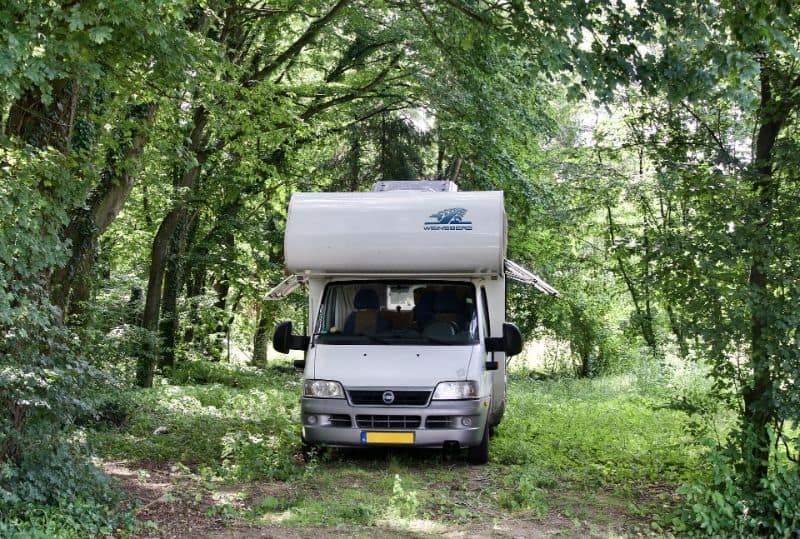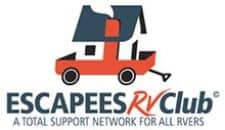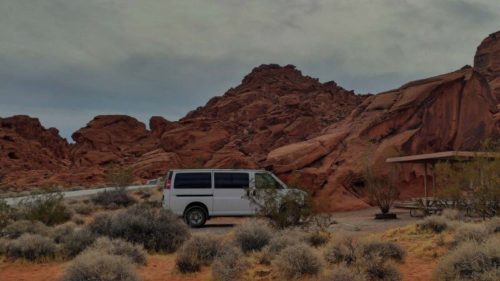
Your RV is designed to be plugged in. If you’re not plugged into “shore power” – a borrowed nautical term – you can only perform primitive functions. Sure, you can switch on the lights and wash your hands – but you can’t run your air conditioner or lounge in a 30-minute shower. You’ll kill your batteries or drain your tanks long before you reach comfort!
Unlike a house, RVs don’t have permanent connections to utilities like water, sewer, and power. You must plug into these utilities at every campsite. These are called “hookups.”
Hookups come in three types:
- Full hookups
- Partial hookups
- No hookups
Get our your jokes about the fourth kind of hookup. We’re all adults. Good. You done?
(Camping without hookups is known as dry camping, dispersed camping, or “boondocking.” We wrote a guide to boondocking here and compiled a list of free camping spots here. Most off-the-lot RVs are not optimized for boondocking. You’ll need more batteries, an inverter, a generator, extra propane, and possibly extra water. But boondocking goes way beyond the scope of this guide!)
Let’s explore what’s included in an RV hookup – and some common mistakes when hooking up.
(Insert one more hookup joke here).
What Is a Standard RV Hookup?
Fair warning: Explaining RV hookups on paper makes it sound a bit more complicated than it actually is. Most of the time, you can hook up in as much time as you can hold your breath. It’s like riding a bike: Once you’ve done it, it’s easy forever.
1. Electrical Hookup
All RVs run off 120-volt single-phase AC (alternating current) electricity.
If you’re not into jargon, don’t worry! This is the same “type” of electricity you use everyday in your own home. Almost anything you plug in at home can be plugged into an RV.
- Small and medium-sized RVs use 30A power. Pop-ups, teardrops, Class B vans, and small travel trailers commonly fall into this category.
- Larger RVs use 50A power. 5th wheels, motorhomes, and larger travel trailers fall into this category. Most RVs with multiple air conditioners, washer/dryer combinations, or electric ovens use 50A power.
30A Connection

50A Connection

What’s the Difference Between a 30A Hookup and a 50A Hookup?
If you’re wondering what’s the difference between 50A and 30A power (hint: the answer isn’t 20A!), then check out our guide to 30A vs 50A power here. Because 50A RVs actually use two hot legs from a 50A 240V connection rather than a single leg from a 30A 120V connection, they actually have more than three times the power!
Most campgrounds offer both 50A and 30A hookups. Sites with 50A are typically larger and more expensive. 30A used to be the most common, but 50A is rapidly becoming the de faco standard at private campgrounds. Most State Parks and National Parks still rely on 30A power.
You can plug your RV into either power source. You’ll need an adapter to go from 30A to 50A and vice versa. Just don’t expect to run two air conditioners when plugged into 30A power. Again, visit our guide to 50A vs 30A power here for more details on plugging into 15, 20, 30, and 50-amp connections.
All RV resorts, parks, and developed campgrounds will have electric hookups. In this day and age, even many “tent camping” sites will have a 15A or 20A power supply, which will work in a pinch. Primitive camping sites will not have any electrical hookups.
If you’re not plugged into power, you cannot use your 110V appliances. Your only alternatives are to A) run a generator or B) invest in an inverter and upgraded battery bank..
When you plug into power, not only can you use your 110V appliances, but the converter will also recharge your batteries!
P.S. Most power pedestals have a separate 15/20-amp outlet (standard household outlet) to power your exterior accessories or appliances.
Hint: Never plug into power without using a surge protector, preferably an EMS! An EMS does far more than protect from voltage spikes; it protects from voltage “brownouts” (a common campground problem), reversed polarity, floating ground, and other dangerous electrical problems.
2. Water Hookup

Your RV has a freshwater tank onboard. It’s most likely sandwiched between your subfloor and your bottom board. This tank (usually 20-50 gallons in size) carries potable water for dry camping. Your on-demand water pump delivers water from the tank to your faucets and spigots.
But when you hook up to campground water, you’re tapping into a campground or municipal water supply. This bypasses your freshwater tank completely! The campground water system is pressurized and will deliver water to your faucets, toilets, and showerheads with pressure only.
All city water hookups are for potable water. You should not hook up to a nonpotable water supply, as this will contaminate your system.
Use a dedicated potable freshwater supply hose when connecting. Don’t use this hose for anything else. Store it in a clean compartment, bleach and clean it regularly, and never get it confused with the black tank rinse hose!
All RV resorts, parks, and developed campgrounds will have water hookups. Primitive camping sites will generally not have site water hookups, although some may have a single shared source of potable water.
Hint 1: The city water pressure may not be well-regulated! You could seriously damage your RV plumbing by connecting to excessive high pressures. Be safe, and use an inline water pressure every time. A safe working water pressure for most RVs is 45-65 psi.
Hint 2: Most RVs have a lever that will allow you to fill up your freshwater tank by diverting the city water into the water tank. Mind the level manually, and turn off the water before the tank overflows! If your RV doesn’t have a tank-fill option, you can manually fill it up using the “gravity” water inlet and a freshwater hose.
3. Sewer Hookup

Most RVs have two wastewater tanks: a “black” and a “gray” tank.
- The black tank holds sewage effluent (human waste) only;
- The gray tank holds effluent from any sinks or showers.
Eventually, these tanks will fill up, and they’ll need to be emptied. Depending on the size of your family and travel style, they may need to be emptied every 3-5 days – or 3-5 weeks!
Virtually all developed campgrounds, even roadside Mom’ n Pop operations, will have at least a communal dump station. You’ll typically empty your tanks while entering or exiting the campground. If you want to
Full hookup sites generally include a private sewer drain, so you don’t have to pack up camp just to go dump your waste.
If you plan to stay longer than a weekend, you may want to set up your sewer hose (aka, Stinky Slinky) for a semi-permanent connection to the sewer drain. But don’t leave your tank valves open constantly! Let the water tanks fill to at least ½ – ¾ full, and then dump – first black, then gray.
Hint: If you don’t have full hookups at your campsite, invest in a wheeled portable tank! These “blue boys” or “honey wagons,” as they are semi-affectionately known, allow you to dump your primary tanks into a portable tank. You can then empty the portable tank at the dump station, so you don’t have to break camp to dump!
4. Entertainment Hookups
All RV parks and resorts, and most developed RV campgrounds, will offer a cable hookup as well. You can insert and twist the cable into the coaxial cable port on the sidewall of your camper.
Check the terms of your campsite reservation. A cable connection may be included in the base rate, or it may require an additional nightly fee.
In the WiFi age, RV internet is no longer considered a “hookup.” You’ll be provided with WiFi network login information when you check into your campsite. Very, very few campsites still have hardwired (e.g. Ethernet) internet access.
For a full walk-through of how to set up an RV with hookups, we invite you to visit this step-by-step visual guide from Progressive.
What’s Included in a Full Hookup for an RV?

RV sites with full hookups include electrical, water, and sewer service.
- The electrical service will be 30A or 50A, depending on which you choose.
- The water connection will be to a potable city water system.
- The sewer service will be a private sewer drain, so you don’t have to pack up camp to drive and dump your tanks.
For nightly and weekend stays, the cost is usually bundled into a single flat rate. Full hookup sites commonly cost $55 – $100 per night!
For long-term stays, water usage and electrical usage may be billed separately in exchange for a lower site rent fee.
FHU sites may also come with other amenities, such as leveled concrete pads and extra picnic tables. Many are pull-through sites, designed for larger 5th wheels and coaches.
FHU PROS
- Best for stays longer than three days
- Full power – can run any appliance
- No generator or inverter needed!
- No water or power rationing
FHU CONS
- Often first booked!
- Most expensive
- Close neighbors
What’s Included in a Partial Hookup for RV?
Partial hookup sites only contain one or two of the three hookup services. Generally, a partial hookup site has water and electric service only; no sewer drain.*
In some cases, a partial hookup site will only offer water or electric. In many small campgrounds, all sites have electric, but a water spigot might be shared among 4-6 campsites.
*While theoretically a PHU site could have sewer+water or sewer+electric, these combinations are very rare.
Since partial hookup sites are often designed with smaller campers in mind, many are back-in sites. If you want pull-through, you might have to upgrade to FHU campsites.
PHU PROS
- More affordable
- More widely available
- Less environmental impact
PHU CONS
- Must pack up to dump (or use portable tank)
- Not always long enough for large (over 35 foot) 5th wheels, travel trailers and motorhomes
- Can’t run generator during quiet hours
No Hookups?

Yes, you can camp without hookups!
Like we mentioned at the beginning of this post, you can “dry camp” and operate your RV on nothing but your house batteries and freshwater tank.
If you’re just staying overnight somewhere, dry camping can be a quick n’ dirty way to cross the country. You can find a comprehensive list of overnight RV parking spots at this list guide.
If you’re serious about boondocking without hookups, start with our boondocking guide.
How Much Do Full Hookups Cost?
RV sites with hookups can cost a pretty penny.
- Full hookup (FHU) sites are especially expensive, usually $15-40 more than a PHU site. Cost is commonly $55-$100 a night ($100 at luxury RV resorts).
- The average cost of a partial hookup (PHU) site is about $45, nationwide. It’s rare to find an RV campground for less than $40 a night, unless you rent weekly/monthly/seasonally.
That’s one of the big reasons we’re big advocates of campground membership programs like Passport America and Escapees RV Club. If you use the membership just twice, you’ll pay for the cost of the membership!
Check out RV discount and savings clubs here. If you camp more than twice a year, you’re literally paying money not to be in one!
Andy Herrick is a blogging nerd, #8 Enneagram, wannabe bread baker, INTJ, RV industry professional, and small business entrepreneur. He can be found hanging out with his lovely wife and family, skiing, cycling, climbing, hiking, and convincing anyone who will listen why dogs aren’t really that great of pets. Also, he runs this website.










